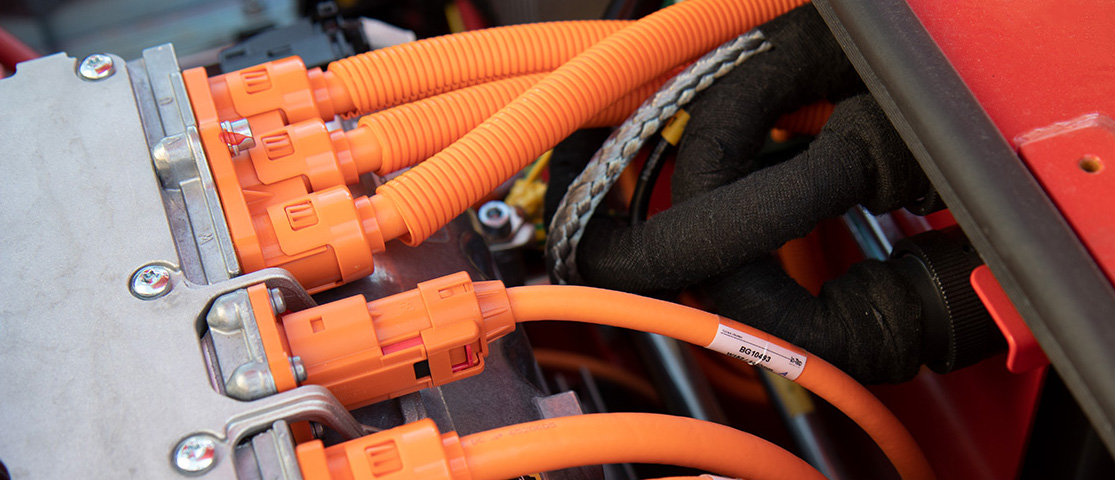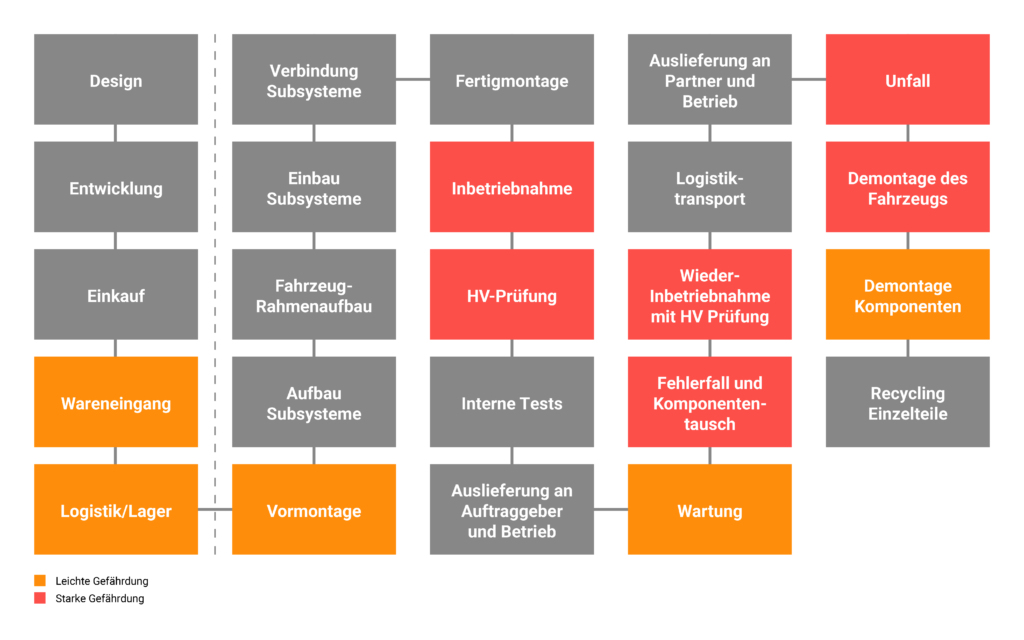
Do you check whether your high-voltage system is implemented in line with the development?
If not, it’s high time you did.
Relevance in development
Commissioning means responsibility
In our article “Functional safety”, we explained the topic of responsibility in detail. It is generally the responsibility of the development department and the project management. It refers explicitly to the functions and malfunctions of a vehicle (e.g. brake pedal does not respond). However, this does not include electrical safety or the quality of the individual end product.
These areas fall within the remit of commissioning. In the area of high-voltage safety, this is ensured by means of test and measurement procedures. If an electrical accident occurs on a vehicle, the values checked during commissioning are assessed so that the question of liability can be clarified.
Who says I’m liable?
In addition to the Product Liability Act, the ECE-R100 and ECE-R10 regulations apply to the marketing of electric vehicles in Europe. Different regulations are in force in other regions of the world. These correspond to the legal bases to be complied with or they either refer to standards or have the same threshold values for safety-relevant measurements.
When is an HV system considered dangerous?
The third part of ISO 6469 is central to the assessment of when an electrical hazard exists. The standard applies to most vehicle classes in Europe. This standard is often referred to, whereby the threshold values correspond to ECE-R100.
| Voltage class | DC in V | AC in V (effective voltage) |
|---|---|---|
| A | 0 < U ≤ 60 | 0 < U ≤ 30 |
| B | 60 < U ≤ 1 500 | 30 < U ≤ 1 000 |
| B1 | 60 < U ≤ 75 | 30 < U ≤ 50 |
| B2 | 75 < U ≤ 1 500 | 50 < U ≤ 1 000 |
According to ISO 6469, stricter regulations apply to voltage classes B-B2 (U > 60VDC) in particular, because a sufficiently high current can flow through the human body at these voltages to cause damage.
A flow through the body only occurs when such a voltage is present and is applied to points that can be touched. A risk assessment of a manufacturing process basically provides information on when this risk exists.
In order to shorten the risk assessment for this article, it is shown along the life cycle of a prototype when a hazard could exist. The danger in this example is the electric shock and/or a self-accelerating runaway of the battery.

Risk assessment of prototypes over the life cycle
In principle, the handling of Li-ion cells or modules is classified as the handling of dangerous goods. The danger here is more from the chemical hazard (leakage) than from the risk of electric shock. Due to the accumulation of hazardous goods, there is also a latent danger in the warehouse. As soon as the module is installed in an enclosure during pre-assembly, it is better protected. Only modules that do not violate the rule U < 60VDC may be connected in series. Only at the end of the “final assembly” step should the module assemblies (strings) be connected to form a complete battery. A voltage of >60 VDC is then present at the contacts.
Caution high voltage
The system can now be put into operation and the HV test should certify that all preventive measures have been taken to protect people, animals and the object itself. During this time, the vehicle must be made inaccessible to laypersons and untrained personnel. The vehicle is only released for the next steps after the successful HV test. These are exemplified in the phases “internal tests, delivery, … maintenance, fault etc.”.
Without appropriate manufacturing processes, the object must be classified as hazardous from the pre-assembly stage (gray background in the figure above).
HV audit
Despite correct manufacturing processes, a potential risk must be assumed until it has been proven that the finished product complies with the regulations. In relation to a vehicle that must comply with ECE R100, the testing experts at Durot Electric have developed a generic approach to test technical accident prevention measures on the vehicle.
1. preparations
- Viewing and checking the HV architecture and schematics
- Determine applicable standards and define measurement parameters
- Checking the fuse coordination (fuse matches the conductor size)
- Check whether all components meet the minimum IP protection requirements
- Writing a test report
- Prepare measuring equipment
2. testing and measuring activities
- Check contact protection and safety distances (e.g. of plug connections)
- Visual inspection of the signaling (line colors, warning stickers, etc.)
- Checking the cable routing (HV/LV separation)
- Visual inspection of the equipotential bonding connections
- Measuring the PA connections
- Line control of the HV system (DC bus)
- Insulation measurement of the entire HV bus
3. functional tests
- Test emergency stop/emergency stop
- Test HV interlock including discharge to U< 60VDC
- Test on-board insulation measuring device (manipulation of the insulation resistance)
- Test interlock against automatic switch-on
- Test braking priority
- Immobilization in the state of charge
- Display of the HV system status (HV bus, direction of travel, error, fault)
4. follow-up work
- Compare measured values with target values in the test report
- List objectionable points
- Highlight failed, safety-relevant tests
- Develop proposals/improvements to the HV system
As the regulations link certain physical values to the operating voltage (e.g. insulation resistance in Ω/VDC), information on threshold values has been neglected in the list. The resulting protocol including measurement data must be kept by the distributor.
Under certain circumstances, this may mean that the vehicle has to be made inaccessible to most of the staff. Above all, however, this means that the above-mentioned test procedure may only be carried out by qualified personnel. This is not prescribed by the vehicle regulations, but by the DGUV (German Social Accident Insurance), for example.
